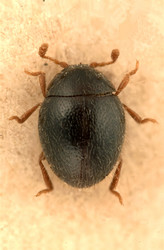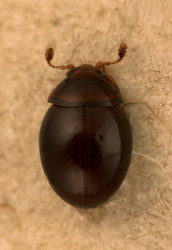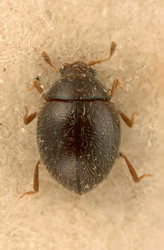Alexiidae
Sphaerosoma
Floyd W. Shockley


This tree diagram shows the relationships between several groups of organisms.
The root of the current tree connects the organisms featured in this tree to their containing group and the rest of the Tree of Life. The basal branching point in the tree represents the ancestor of the other groups in the tree. This ancestor diversified over time into several descendent subgroups, which are represented as internal nodes and terminal taxa to the right.

You can click on the root to travel down the Tree of Life all the way to the root of all Life, and you can click on the names of descendent subgroups to travel up the Tree of Life all the way to individual species.
For more information on ToL tree formatting, please see Interpreting the Tree or Classification. To learn more about phylogenetic trees, please visit our Phylogenetic Biology pages.
close boxIntroduction
Alexiidae (=Sphaerosomatidae) is a small family of mycophagous beetles within the Cerylonid-Series of the superfamily Cucujoidea containing only a single genus, Sphaerosoma Samouelle, and 53 species. Species of Sphaerosoma are geographically restricted to the Palearctic, ranging from southern Europe to North Africa and Asia Minor (Lawrence 1991, Tomaszewska 2007), but two undescribed genera that might be placed in this family are known from Southeast Asia and the Neotropics. Alexiids are rather similar in overall appearance to a number of other small mycophagous taxa. Although their biology has largely remained undocumented, alexiids are known to frequent the fruitings of softer agarics, and Lawrence (1991) specifically recorded them from species of Armillaria, Collybia, Hypholoma, Russula, Mycena, Panus, Pholiota, Schizophyllum and Tricholoma.
Characteristics
Adults of the family are recognizable by the small size (1.2-1.7 mm), and globose, hirsute habitus (clothed with short fine hairs). They can be distinguished from related taxa by the combination of the following characters: antennae 10-segmented with a 3-segmented club, frontoclypeal suture present, strongly curved postcoxal lines present on the metaventrite, mesotarsus with ventral lobes on the antepenultimate tarsomere only (but still clearly tetramerous), maxillary and labial palpi slightly to strongly securiform apically, 7 abdominal spiracles, wings usually absent, procoxal cavities internally open and mesocoxal cavities laterally open (Lawrence et al. 1999b).
Within the family, larvae are known for only two species: Sphaerosoma aligiricum Reitter and S. piliferum (Muller). Larvae are minute (less than 2.5 mm) but elongate. Dorsal surfaces granulate with variable pigmentation and vestiture of moderately long but scattered simple setae (Lawrence 1982). Alexiid larvae can be distinguished from other similar larvae by the combination of the following characters (based on Lawrence 1991, Lawrence et al. 1999a): head with lyriform frontal arms but lacking epicranial stem, 5 pairs of stemmata, frontoclypeal suture absent, mandibles tridentate with a tuberculate mola and lacking a prostheca, urogomphi well-developed and spiracles tuberculate biforous.
Taxonomy
The taxonomic history of Alexiidae is somewhat complex and has been the subject of confusion in the past. The genus Sphaerosoma was erected by Samouelle (1819) based on an unpublished manuscript name provided by Leach. The generic name Alexia was later proposed by Stephens (1833). However, Alexia was unavailable since the name was already occupied as a genus of Mollusca (Ganglbauer 1899). Champion (1887) proposed the generic name Hygrotophila to replace Alexia, apparently not realizing that Hygrotophila was itself a junior synonym of Agaricophilus Motschulsky (Endomychidae: Mycetaeinae). Apfelbeck (1910, 1915, 1916) proposed a system of subgenera (Lamprosphaerula, Arthrosphaerula, Neosphaerula, Sphaerosoma) for separating the different morphotypes of Sphaerosoma based on variation in pubescence, antennal characters and the sexually dimorphic condition of the male prothoracic tarsi in some taxa. Strohecker (1953) included a key to these subgenera using these same characters, but then immediately condemned their use. Tomaszewska (2007) included these subgenera in her treatment of Alexiidae of the Palearctic Region, so for now they have been retained in the tree structure.
As pointed out by Lawrence and Newton (1995), the family-level name Alexiidae Imhoff, 1856 has priority over its proposed replacement, Sphaerosomatidae Ganglbauer, 1899. In this case, the family-level names Alexiidae and, by the Principle of Coordination, the single nominate subfamily, Alexiinae, are based on the junior synonym of the monotypic genus rather than the valid name. Pakaluk et al. (1994) and Lawrence and Newton (1995) noted that Article 40b of the ICZN might allow conservation of the more widely used Sphaerosomatidae over Alexiidae. However, these authors did not see fit to submit a formal petition to the Commission and chose to leave the family-level name based on strict priority.
Alexiidae (as Sphaerosomatinae) was considered a subfamily of Endomychidae by Strohecker (1953) and Crowson (1967). The subfamily was subsequently elevated to the family level by Lawrence (1982) and reassigned the family name Alexiidae by Pakaluk et al. (1994).
Relationship of Alexiidae to Other Cucujoidea
Lawrence (1991) suggested that Alexiidae had affinities with Bothrideridae and Cerylonidae. Slipinski and Pakaluk (1991) suggested that Alexiidae was more closely allied with Coccinellidae and Endomychidae. The only phylogenetic analysis that specifically included Alexiidae recovered it within the Cerylonid-Series with possible sister-group relationships with both Anamorphinae (Endomychidae) and a clade containing Latridiidae and Discolomatidae (Hunt et al. 2007). Robertson et al. (2008) conducted the first formal phylogenetic analysis to test the monophyly of the Cerylonid-Series and to investigate the phylogenetic relationships between its constituent families. Unfortunately, that analysis did not include Alexiidae. Clearly, more work is needed to properly resolve the placement of Alexiidae within the Cerylonid-Series.
References
Apfelbeck, V. 1910. Beitrage zur Kenntnis der Kaferfauna der Balkanhalbinsel. Pp. 40-42. In: Bericht der Sektion fur Koleopterologie. Versammlung am 3. February 1910. Verhandlungen der Kaiserlich-Koniglichen Zoologisch-Botanischen Gesellschaft in Wien 60: 40-49.
Apfelbeck, V. 1915. Revizija vrsta roda Sphaerosoma Leach balkanskog poluostrva (Col.). Glasnik Zemaljskog Muzeja u Bosni I Hercegovini 27: 407-429.
Apfelbeck, V. 1916. Zur Kenntnis der Gattung Sphaerosoma Leach (Col.). Revision der Arten von der Balkanhalbinseln. Annales Historico-Naturales Musei Nationalis Hungarici 14: 471-500
Crowson, R. A. 1967. The Natural Classification of the Families of Coleoptera. E.W. Classey Ltd., Hampton, England. pp.
Ganglbauer, L. 1899. Die Kafer von Mitteleuropa. Die Kafer der osterreichisch-ungarischen Monarchie, Deutschlands, der Schweiz, sowiw des franzosischen und italienischen Alpengebietes. Vol. 3, Familienreihe Staphylinoidea. II. Theil. & Familienreihe Clavicornia. Carl Gerolds Sohn, Wien.
Hunt, T., J. Bergsten, Z. Levkanicova, A. Papadopoulou, O. St. John, R. Wild, P. M. Hammond, D. Ahrens, M. Balke, M. S. Caterino, J. Gomez-Zurita, I. Ribera, T. G. Barraclough, M. Bocakova, L. Bocak, and A. P. Vogler. 2007. A comprehensive phylogeny of beetles reveals the evolutionary origins of a superradiation. Science 318: 1913-1916.
Imhoff, L. 1856. Versuch einer Einfuhrung in das Studium der Koleopteren. Privately published, Basel, xxxi + 114 + 272 pp., 25 + 1 pls.
Lawrence, J. F. 1982. Coleoptera, pp. 482-553. In S. P. Parker [ed.], Synopsis & Classification of Living Organisms. McGraw Hill, Inc., New York.
Lawrence, J. F. 1991. Endomychidae (Cucujoidea)(including Merophysiidae, Mycetaeidae), pp. 482-485. In F. W. Stehr [ed.], Immature Insects. Volume 2. Kendall/Hunt Publishing Company, Dubuque, IA.
Lawrence, J. F., and A. F. Newton. 1995. Families and subfamilies of Coleoptera (with selected genera, notes, references and data on family-group names), pp. 779-1006. In J. Pakaluk and S. A. Slipinski [eds.], Biology, Phylogeny, and Classification of Coleoptera: Papers Celebrating the 80th Birthday of Roy A. Crowson. Museum i Instytut Zoologii PAN, Warszawa.
Lawrence, J. F., A. M. Hastings, M. J. Dallwitz, T. A. Paine, and E. J. Zurcher. 1999a. Endomychidae. Beetle Larvae of the World: Descriptions, Illustrations, Identification, and Information Retrieval for Families and Sub-families. CD-ROM, version 1.1 for MS-Windows. CSIRO Publishing, Melbourne.
Lawrence, J. F., A. M. Hastings, M. J. Dallwitz, T. A. Paine, and E. J. Zurcher. 1999b. Endomychidae (major part). Beetles of the World: A Key and Information System for Families and Subfamilies. CD-ROM, version 1.0 for MS-Windows. CSIRO Publishing, Melbourne.
Pakaluk, J., S. A. Slipinski, and J. F. Lawrence. 1994. Current classification and family-group names in Cucujoidea (Coleoptera). Genus 5: 223-268.
Robertson, J. A., M. F. Whiting, and J. V. McHugh. 2008. Searching for natural lineages within the Cerylonid Series (Coleoptera: Cucujoidea). Molecular Phylogenetics and Evolution 46: 193-205.
Samouelle, G. 1819. The Entomologist’s useful compendium; or an introduction to the knowledge of British insects, comprising the best means of obtaining and preserving them, and a description of the apparatus generally used; together with the genera of Linne, and the modern method of arranging the classes Crustacea, Myriapoda, spiders, mites, and insects from their affinities and structure, according to the views of Dr. Leach. Also an explanation of the term used in entomology; a calendar of the times of appearance and usual situation of near 3000 species of British insects; with instructions for collecting and fitting up objects for the microscope. Thomas Boys, London. 496 pp.
Slipinski, S. A., and J. Pakaluk. 1991. Problems in the classification of the Cerylonid series of Cucujoidea (Coleoptera), pp. 79-88. In M. Zunino, X. Belles and M. Blas [eds.], Advances in Coleopterology. AEC, Barcelona.
Strohecker, H. F. 1953. Coleoptera, Endomychidae, pp. 1-145. In P. Wytsman [ed.], Genera Insectorum. Louis Desmet-Verteneuil, Bruxelles.
Tomaszewska, K.W. 2007. Alexiidae, pp. 555-556. In: I. Lobl and A. Smetana [eds.], Catalogue of Palaearctic Coleoptera. Volume 4. Elateroidea - Derodontoidea - Bostrichoidea - Lymexyloidea - Cleroidea - Cucujoidea. Apollo Books, Stenstrup.
Information on the Internet
- Checklist of the Alexiidae of the World (Coleoptera: Cucujoidea)
- Fauna Europaea - Alexiidae
- Strohecker Endomychidae Collection, Florida State Collection of Arthropods (includes Alexiidae as Sphaerosoma)
- Alexiidae Images at Insect Images.org
Title Illustrations

| Scientific Name | Sphaerosoma corcyreum (Reitter) |
|---|---|
| Specimen Condition | Dead Specimen |
| Identified By | F.W. Shockley |
| Life Cycle Stage | Adult |
| View | Dorsal habitus |
| Copyright |
© Nathan P. Lord

|
| Scientific Name | Sphaerosoma globosum (Sturm) |
|---|---|
| Specimen Condition | Dead Specimen |
| Identified By | F.W. Shockley |
| Life Cycle Stage | Adult |
| View | Dorsal habitus |
| Copyright |
© Nathan P. Lord

|
| Scientific Name | Sphaerosoma pilosum (Panzer) |
|---|---|
| Specimen Condition | Dead Specimen |
| Identified By | F.W. Shockley |
| Life Cycle Stage | Adult |
| View | Dorsal habitus |
| Copyright |
© Nathan P. Lord

|
About This Page
I gratefully acknowledge Nathan Lord for shooting and editing the high resolution pictures above from specimens housed in my research collection. Special thanks to Joseph V. McHugh for reviewing the text and offering useful comments/suggestions. Partial support for the construction of this page was provided by the H.H. Ross Endowment of the Department of Entomology at the University of Georgia, through an NSF AToL grant EF-0531665 to M.F. Whiting (subcontract to J.V. McHugh) and through an NSF PEET grant (DEB-0329115) to J.V. McHugh, M.F. Whiting, and K.B. Miller.
Floyd W. Shockley

Dept. of Entomology, National Museum of Natural History, Smithsonian Institution
Correspondence regarding this page should be directed to Floyd W. Shockley at
ShockleyF@si.edu
Page copyright © 2011 Floyd W. Shockley
 Page: Tree of Life
Alexiidae . Sphaerosoma .
Authored by
Floyd W. Shockley.
The TEXT of this page is licensed under the
Creative Commons Attribution-NonCommercial License - Version 3.0. Note that images and other media
featured on this page are each governed by their own license, and they may or may not be available
for reuse. Click on an image or a media link to access the media data window, which provides the
relevant licensing information. For the general terms and conditions of ToL material reuse and
redistribution, please see the Tree of Life Copyright
Policies.
Page: Tree of Life
Alexiidae . Sphaerosoma .
Authored by
Floyd W. Shockley.
The TEXT of this page is licensed under the
Creative Commons Attribution-NonCommercial License - Version 3.0. Note that images and other media
featured on this page are each governed by their own license, and they may or may not be available
for reuse. Click on an image or a media link to access the media data window, which provides the
relevant licensing information. For the general terms and conditions of ToL material reuse and
redistribution, please see the Tree of Life Copyright
Policies.
- First online 24 June 2008
- Content changed 24 June 2008
Citing this page:
Shockley, Floyd W. 2008. Alexiidae . Sphaerosoma . Version 24 June 2008 (under construction). http://tolweb.org/Sphaerosoma/65850/2008.06.24 in The Tree of Life Web Project, http://tolweb.org/











 Go to quick links
Go to quick search
Go to navigation for this section of the ToL site
Go to detailed links for the ToL site
Go to quick links
Go to quick search
Go to navigation for this section of the ToL site
Go to detailed links for the ToL site